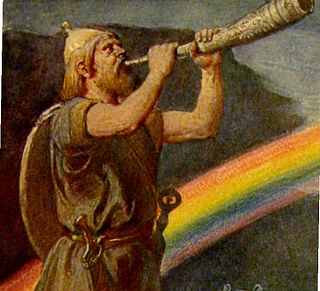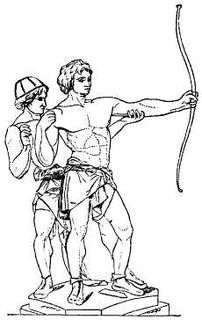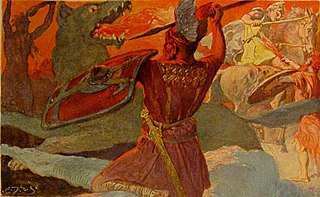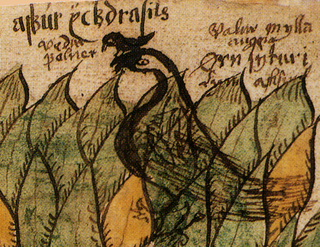
In Norse mythology, Bifröst is a burning rainbow bridge that reaches between Midgard (Earth) and Asgard, the realm of the gods. The bridge is attested as Bilröst in the Poetic Edda; compiled in the 13th century from earlier traditional sources, and as Bifröst in the Prose Edda; written in the 13th century by Snorri Sturluson, and in the poetry of skalds. Both the Poetic Edda and the Prose Edda alternately refer to the bridge as Ásbrú.

In Norse mythology, Geri and Freki are two wolves which are said to accompany the god Odin. They are attested in the Poetic Edda, a collection of epic poetry compiled in the 13th century from earlier traditional sources, in the Prose Edda, written in the 13th century by Snorri Sturluson, and in the poetry of skalds. The pair has been compared to similar figures found in Greek, Roman and Vedic mythology, and may also be connected to beliefs surrounding the Germanic "wolf-warrior bands", the Úlfhéðnar.

Höðr is a blind god and a son of Odin and Frigg in Norse mythology. Tricked and guided by Loki, he shot the mistletoe arrow which was to slay the otherwise invulnerable Baldr.

Völuspá is the first and best known poem of the Poetic Edda. It tells the story of the creation of the world and its coming end, related to the audience by a völva addressing Odin. It is one of the most important primary sources for the study of Norse mythology. Henry Adam Bellows proposed a 10th-century dating and authorship by a pagan Icelander with knowledge of Christianity. He also assumes the early hearers would have been very familiar with the "story" of the poem and not in need of an explanation.
The Prose Edda, also known as the Younger Edda, Snorri's Edda or, historically, simply as Edda, is an Old Norse work of literature written in Iceland during the early 13th century. The work is often assumed to have been written, or at least compiled, by the Icelandic scholar, lawspeaker, and historian Snorri Sturluson c. 1220. It is considered the fullest and most detailed source for modern knowledge of Germanic mythology.
In Norse cosmology, Vanaheimr is a location associated with the Vanir, a group of gods themselves associated with fertility, wisdom, and the ability to see the future.
In Norse mythology, Níðhöggr is a dragon/serpent who gnaws at a root of the world tree, Yggdrasil. In historical Viking society, níð was a term for a social stigma implying the loss of honor and the status of a villain. Thus, its name might refer to its role as a horrific monster in its action of chewing the corpses of the inhabitants of Náströnd: those guilty of murder, adultery, and oath-breaking, which Norse society considered among the worst possible.

Mímir or Mimir is a figure in Norse mythology, renowned for his knowledge and wisdom, who is beheaded during the Æsir-Vanir War. Afterward, the god Odin carries around Mímir's head and it recites secret knowledge and counsel to him.
In Norse mythology, Sæhrímnir is the creature killed and eaten every night by the Æsir and einherjar. The cook of the gods, Andhrímnir, is responsible for the slaughter of Sæhrímnir and its preparation in the cauldron Eldhrímnir. After Sæhrímnir is eaten, the beast is brought back to life again to provide sustenance for the following day. Sæhrímnir is attested in the Poetic Edda, compiled in the 13th century from earlier traditional material, and the Prose Edda, written in the 13th century by Snorri Sturluson.
In Norse mythology, Bestla is the mother of the gods Odin, Vili and Vé by way of Borr, the sister of an unnamed being who assisted Odin, and the daughter or, depending on source, granddaughter of the jötunn Bölþorn. Bestla is attested in the Poetic Edda, compiled in the 13th century from earlier traditional sources, the Prose Edda, written in the 13th century by Snorri Sturluson, and in the poetry of skalds. Scholars have commented on the obscurity of the figure's name and have proposed that she may be the wise being Mímir's sister.
In Norse mythology, Bölþorn or Bölþor is a jötunn, the father of Bestla, and therefore grandfather of the gods Odin, Vili and Vé. The figure receives mention in the Poetic Edda, composed in the 13th century from earlier traditional sources, and the Prose Edda, compiled by Icelander Snorri Sturluson in the 13th century. Scholars have noted that the Poetic Edda mention may mean that he is the father of the wise being Mímir.

In Norse mythology, Vígríðr or Óskópnir is a large field foretold to host a battle between the forces of the gods and the forces of Surtr as part of the events of Ragnarök. The field is attested in the Poetic Edda, compiled in the 13th century from earlier traditional material, and in the Prose Edda, written by Snorri Sturluson in the 13th century. The Poetic Edda briefly mentions the field as where the two forces will battle, whereas the Prose Edda features a fuller account, foretelling that it is the location of the future death of several deities before the world is engulfed in flames and reborn.
In Norse mythology, Hoddmímis holt is a location where Líf and Lífþrasir are foretold to survive the long winters of Fimbulvetr. Hoddmímis holt is attested in the Poetic Edda, compiled in the 13th century from earlier traditional sources, and the Prose Edda, written in the 13th century by Snorri Sturluson. Like the very similarly named Mímameiðr, scholars generally consider Hoddmímis holt to be another name for Yggdrasil and connect it to folklore recorded from Germanic Europe.

Norse cosmology is the study of the cosmos (cosmology) as perceived by the North Germanic peoples. The topic encompasses concepts from Norse mythology, such as notions of time and space, cosmogony, personifications, anthropogeny, and eschatology. Like other aspects of Norse mythology, these concepts are primarily recorded in the Poetic Edda, a collection of poems compiled in the 13th century, and the Prose Edda, authored by Icelander Snorri Sturluson in the 13th century, who drew from earlier traditional sources. Together these sources depict an image of Nine Worlds around a cosmic tree, Yggdrasil.

In Norse mythology, Gjallarhorn is a horn associated with the god Heimdallr and the wise being Mímir. Gjallarhorn is attested in the Poetic Edda, compiled in the 13th century from earlier traditional material, and the Prose Edda, written in the 13th century by Snorri Sturluson.

In Norse mythology, Veðrfölnir is a hawk sitting between the eyes of an unnamed eagle that is perched on top of the world tree Yggdrasil. Veðrfölnir is sometimes modernly anglicized as Vedrfolnir, Vedfolnir or Vethrfolnir.
In Norse mythology, Barri is the place where Freyr and Gerðr are to consummate their union, as stated in the Skírnismál:

In Norse mythology, Himinbjörg is the home of the god Heimdallr. Himinbjörg is attested in the Poetic Edda, compiled from earlier traditional sources, and the Prose Edda and Heimskringla, both written in the 13th century by Snorri Sturluson. Himinbjörg is associated with Heimdallr in all sources. According to the Poetic Edda, Heimdallr dwells there as watchman for the gods and there drinks fine mead, whereas in the Prose Edda Himinbjörg is detailed as located where the burning rainbow bridge Bifröst meets heaven. Scholars have commented on the differences between the two attestations and linked the name of the mythical location to various place names.
In Norse mythology, Sindri is the name of both a character and a hall that will serve as a dwelling place for the souls of the virtuous after Ragnarök.

In Norse mythology, Mímisbrunnr is a well associated with the being Mímir, located beneath the world tree Yggdrasil. Mímisbrunnr is attested in the Poetic Edda, compiled in the 13th century from earlier traditional sources, and the Prose Edda, written in the 13th century by Snorri Sturluson. The well is located beneath one of three roots of the world tree Yggdrasil, a root that passes into the land of the frost jötnar where the primordial plane of Ginnungagap once existed. In addition, the Prose Edda relates that the water of the well contains much wisdom, and that Odin sacrificed one of his eyes to the well in exchange for a drink.














